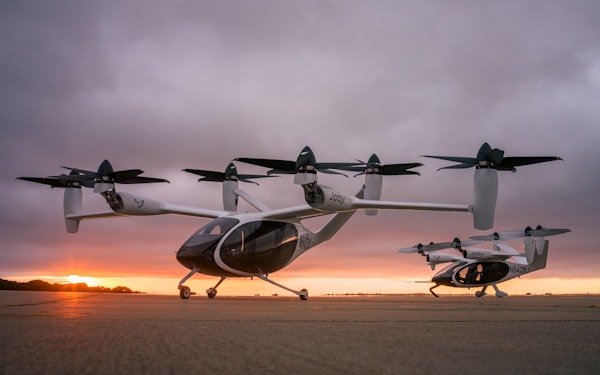They’re coming, part one.
Aviation startup Alef Aeronautics recently received Federal Aviation Administration approval to test its flying car.
Details: The all-electric “Model A” is designed to take off and land vertically, putting it in the emerging category of eVTOL — electric vertical takeoff and landing — aircraft.
- Alef expects to sell the Model A for $300,000 a piece, and says it has received hundreds of pre-orders.
Reality check: “Flying cars” have captured the public’s imagination since one appeared in the 1974 Bond flick “The Man With the Golden Gun” — but such projects usually fizzle out.
Flying cars tend to be both bad cars and bad airplanes.
- Case in point: The Alef is being designed to have 200 miles of road range or 110 miles of airborne range, and can carry a max of just two people.
- Those aren’t impressive numbers. Today’s best electric cars are topping 300 miles of range, while even your basic four-seat Cessna 172 can cover over 600 nautical miles without refueling.
- Plus, the Alef is limited to just 25 mph while in driving mode.
The bottom line: eVTOLS are coming, but they probably won’t be privately owned — think more “Uber for the skies” than “car I can fly.”
Hold that thought, because here’s part two.
Joby Aviation has been cleared by the FAA (Federal Aviation Authority) to start flight tests on its first production prototype air taxi, the company wrote in a press release. It’s a large step in the company’s aim to start shipping the eVTOL aircraft (electric vertical takeoff and landing) to customers in 2024 and launch an air taxi service by 2025.
“The aircraft will now undergo initial flight testing before being delivered to Edwards Air Force Base, California, where it will be used to demonstrate a range of potential logistics use cases,” Joby wrote.
The aircraft can take off and land like a helicopter, then tilt its six rotors horizontally and fly like an airplane at up to 200 MPH. It’s designed to carry a pilot and four passengers over a distance up to 100 miles on a charge — enough range for most types of air taxi operations. At the same time, Joby claims it’s nearly silent in cruise mode and 100 times quieter than conventional aircraft during takeoff and landing.
Joby’s first production prototype recently rolled off the company’s assembly line in Marina, California. The plant was built in partnership with Toyota, Joby’s largest investor with a $394 million stake. Cementing that relationship, Joby announced that it was appointing Toyota North America CEO Tetsuo (Ted) Ogawa to the board of directors.
The production prototype eVTOL — Joby’s third full-scale prototype — also received a special airworthiness certificate issued by the Federal Aviation Administration (FAA) and can now begin flight testing.
“This first aircraft coming off our pilot manufacturing line is a really, really big deal for the company,” JoeBen Bevirt, founder and CEO of Joby, told TechCrunch. “We have spent many years building the processes and procedures and capabilities as an organization to be able to deliver this level of of aircraft. We’ve been building since 2017, but to be able to build with this level of rigor is a huge step forward. It prepares us for this next stage of the certification process.”
Joby has already flown more than 30,000 miles since 2019 on pre-production prototype aircraft. This latest iteration builds on that experience and puts the company closer to achieving type certification with the FAA. Type certification means that the FAA approves of Joby’s aircraft design and component parts, and that the design is compliant with the agency’s standards for airworthiness and noise.
Joby nearly has three out of the five necessary stages of the type certification process underway, according to Bevirt. The final step after type certification would be production certification, which will allow Joby to mass produce eVTOLs under FAA-approved designs.
[…]
Bevirt wouldn’t say where Joby intends to commercialize air taxi operations first, but he did say that the company has been working closely with the Japan Civil Aviation Bureau, which Bevirt describes as “extremely forward leaning.”
“We’ll be continuing to engage with them on our path to bringing the service to Japan,” he said.
I’ve blogged a lot about flying cars, most recently two years ago. Looking back, it seems like there have been a lot of prototypes, and not much that came anywhere close to the market. These two at least look to be more realistic in the short to medium term. I can see the use case for “flying taxis” – we do already have helicopters for that purpose, almost entirely for the very rich because those things are super expensive – and if they’re electric then that at least makes them somewhat less objectionable. Safety, not just for the passengers and pilots but also for the people on the streets below since these are intended for urban areas, as a way to beat the traffic, remains a big question, and even if the price for a ride is a lot less than for a helicopter it’s still not going to be cheap. Just know that when these things do come to Texas, the only rules for them will come from the feds and from the Legislature, since the cities will be barred from putting any restrictions on them unless they can prevail in their litigation against the Death Star bill. Look, up in the sky, it’s a bird, it’s a plane, it’s two tons of debris about to fall on your head.



Would these even be insurable? Two of them collide and plummet into a school, causing a mass-casualty event. How does one even speculate about a potential payout for that?
If helicopters are insurable, then I assume these will be as well. At what price point, that’s another question.